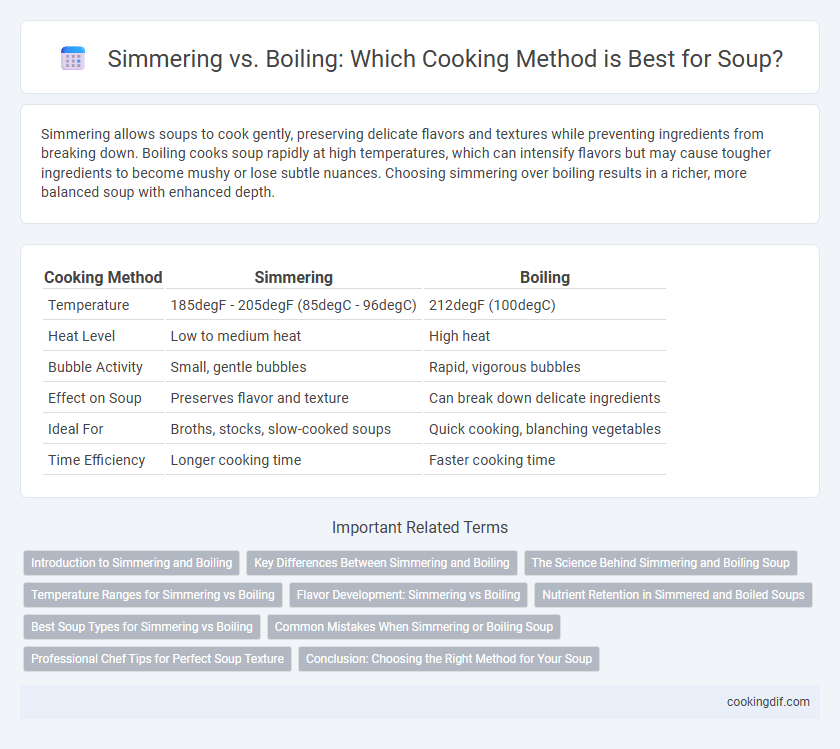Simmering allows soups to cook gently, preserving delicate flavors and textures while preventing ingredients from breaking down. Boiling cooks soup rapidly at high temperatures, which can intensify flavors but may cause tougher ingredients to become mushy or lose subtle nuances. Choosing simmering over boiling results in a richer, more balanced soup with enhanced depth.
Table of Comparison
| Cooking Method | Simmering | Boiling |
|---|---|---|
| Temperature | 185degF - 205degF (85degC - 96degC) | 212degF (100degC) |
| Heat Level | Low to medium heat | High heat |
| Bubble Activity | Small, gentle bubbles | Rapid, vigorous bubbles |
| Effect on Soup | Preserves flavor and texture | Can break down delicate ingredients |
| Ideal For | Broths, stocks, slow-cooked soups | Quick cooking, blanching vegetables |
| Time Efficiency | Longer cooking time | Faster cooking time |
Introduction to Simmering and Boiling
Simmering maintains soup at a gentle heat just below boiling point, typically around 185degF to 205degF, allowing flavors to meld and ingredients to cook evenly without breaking apart. Boiling occurs at 212degF, causing vigorous bubbles that rapidly cook food but can toughen meats and cloud broths. Understanding these temperature differences helps achieve the desired texture and clarity in soups.
Key Differences Between Simmering and Boiling
Simmering maintains a gentle heat between 185degF and 205degF, allowing flavors to meld and tough ingredients to tenderize without breaking apart, ideal for delicate soups and stocks. Boiling occurs at 212degF, creating rapid bubbles that aggressively cook food but can cause loss of flavor and texture, making it suitable for pasta or blanching. The key difference lies in temperature control and intensity, where simmering preserves soup clarity and texture, while boiling accelerates cooking but risks overcooking and cloudy broth.
The Science Behind Simmering and Boiling Soup
Simmering soup involves cooking liquid at a temperature just below boiling, typically around 185-205degF (85-96degC), which allows flavors to meld gently without aggressive agitation. Boiling occurs at 212degF (100degC) and causes rapid movement that can break down delicate ingredients and oversaturate the broth with unwanted cloudiness. The controlled heat of simmering preserves nutrient content and texture, making it the preferred method for slow-cooked soups and stews.
Temperature Ranges for Simmering vs Boiling
Simmering occurs at a temperature range of approximately 185degF to 205degF (85degC to 96degC), where gentle bubbles form and it maintains a low, steady heat ideal for slowly developing flavors in soup without breaking down ingredients. Boiling happens at 212degF (100degC) at sea level, characterized by rapid, continuous bubbles that agitate the soup vigorously, which can lead to faster cooking but risks overcooking delicate components. Controlling the temperature between simmering and boiling ensures optimal texture and flavor extraction in various soup recipes.
Flavor Development: Simmering vs Boiling
Simmering enhances flavor development in soups by allowing ingredients to release their essences slowly and meld harmoniously, preserving delicate aromas and producing a richer, more nuanced taste. Boiling rapidly agitates the liquid, which can cause volatile flavors to dissipate and proteins to toughen, resulting in a less refined soup flavor. Optimal soup preparation balances gentle simmering to extract depth and complexity without sacrificing ingredient integrity.
Nutrient Retention in Simmered and Boiled Soups
Simmering soup at lower temperatures preserves more heat-sensitive vitamins such as vitamin C and B-complex compared to boiling, which can cause nutrient degradation due to intense heat. Boiling often leads to nutrient leaching into the cooking water, but simmering reduces this loss by maintaining gentler heat that slows nutrient breakdown. Therefore, simmered soups generally offer higher nutrient retention, enhancing the nutritional quality of the final dish.
Best Soup Types for Simmering vs Boiling
Simmering is ideal for delicate soups like minestrone, chicken noodle, and bisques, as it gently melds flavors and preserves texture without breaking down ingredients. Boiling suits hearty soups such as cabbage soup, split pea, and lentil, where intense heat efficiently softens tough ingredients and accelerates cooking time. Choosing simmering or boiling depends on the soup's ingredients and desired flavor depth to achieve optimal taste and consistency.
Common Mistakes When Simmering or Boiling Soup
Overheating soup by boiling instead of simmering often leads to toughened meats and broken vegetables due to excessive agitation. Failing to adjust heat gradually causes sudden temperature spikes, resulting in uneven cooking and loss of delicate flavors. Ignoring the importance of maintaining a gentle simmer can cause broth clarity to decline, making the soup cloudy and less visually appealing.
Professional Chef Tips for Perfect Soup Texture
Simmering soup at a gentle temperature between 180degF and 205degF preserves delicate flavors and prevents ingredients from breaking down, ensuring a silky texture favored by professional chefs. Boiling at 212degF can cause rapid agitation that toughens proteins and overcooks vegetables, resulting in a cloudy broth and uneven mouthfeel. Master chefs recommend maintaining a consistent simmer to develop depth of flavor and achieve the ideal velvety texture in soups.
Conclusion: Choosing the Right Method for Your Soup
Simmering preserves delicate flavors and textures, making it ideal for broths and light soups, while boiling suits hearty, chunky soups that require faster cooking. Temperature control is crucial; maintaining a simmer (around 185-205degF or 85-96degC) ensures ingredients meld without breaking down, whereas boiling (212degF or 100degC) can cause overcooking or cloudy broth. Selecting the right method depends on the soup's ingredients and desired consistency to achieve optimal taste and presentation.
Simmering vs Boiling for cooking method Infographic

 cookingdif.com
cookingdif.com